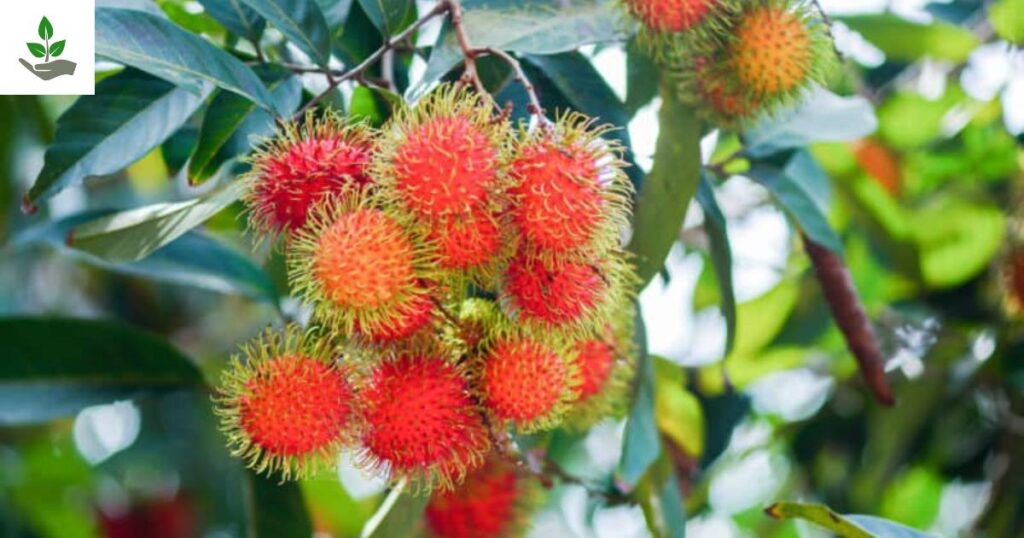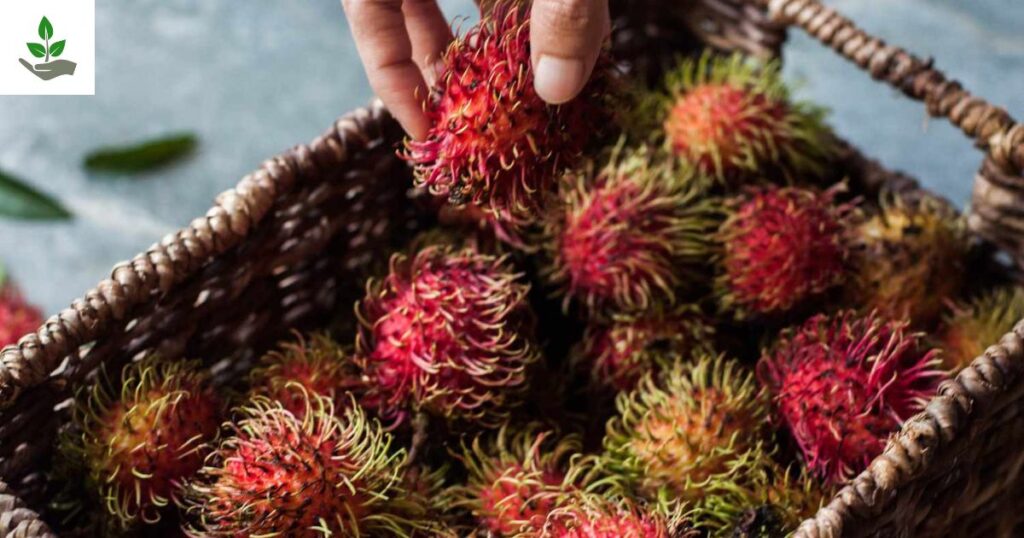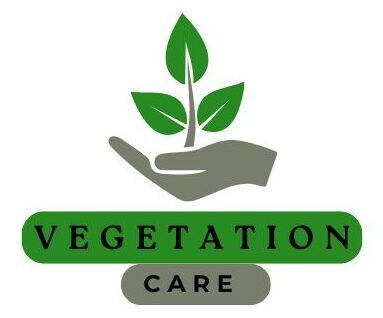Rambutan Fruit Care, Planting, Types And Benefits
That rambutan fruit with its vibrant red and hairy exterior is not only a visual delight but also a powerhouse of nutrients. This exotic tropical fruit is gaining popularity among health enthusiasts for its impressive health benefits and unique flavor. Join us on this journey to unlock the secrets of growing and enjoying rambutan fruit.
In this article we will delve into the essentials of Rambutan Fruit Care, the best planting techniques, various types of rambutan and the numerous advantages of incorporating this fruit into your diet. By the end you will be equipped with all the knowledge needed to cultivate and enjoy this remarkable fruit.
What Is Rambutan Fruit?
Rambutan fruit native to the tropical regions of Southeast Asia is a strikingly unique fruit that captivates both the eyes and the palate. Its name derived from the Malay word for hair aptly describes its spiky hairy exterior which ranges in color from vibrant red to yellow when ripe.

Inside the translucent flesh resembles that of a lychee with a juicy sweet flavor that can evoke hints of grapes and floral notes. This exotic fruit not only delights with its taste but also offers a treasure trove of nutritional benefits including high levels of vitamin C fiber and antioxidants.
Rambutan Fruit History
Native to the tropical regions of Malaysia and Indonesia this fruit has been cultivated for centuries often revered not only for its unique taste but also for its nutritional benefits. The name rambutan derives from the Malay word rambut meaning hair aptly describing its distinctive hairy shell. It was not just a food source. It played a role in traditional medicine where various parts of the tree were used to treat ailments ranging from fever to skin infections.
Rambutan Fruit Overview
| Scientific Name | Nephelium lappaceum |
| Common Name | Rambutan |
| Family | Sapindaceae |
| Origin | Southeast Asia |
| Appearance | Hairy or spiky red or yellow skin |
| Taste | Sweet, mildly acidic |
| Nutritional Value | High in Vitamin C |
| Health Benefits | boosts iron levels, aids digestion |
| Cultivation | typically on trees up to 20-25 meters tall |
| arvest Season | depending on region |
What Are Rambutan Fruit Types?
- Rongrien (Thailand)
- Lebak Bulus (Indonesia)
- Maharlika (Philippines)
- Jitlee (Thailand)
- Binjai (Indonesia/Malaysia)
Rongrien
Nestled within the verdant landscapes of Thailand, Rongrien offers a unique blend of traditional Thai culture and stunning natural beauty. This charming destination is often overshadowed by its more famous neighbors, yet it boasts an authenticity that captivates adventurous travelers seeking a deeper connection with local life.

The small fishing village showcases vibrant markets brimming with fresh produce and artisanal crafts, allowing visitors to immerse themselves in the daily rhythms of Thai living.
Lebak Bulus
Lebak Bulus located in South Jakarta is a vibrant neighborhood that seamlessly blends urban life with a touch of nature. Once primarily known for its modest residential areas it has transformed into a burgeoning hub of modern development especially with the recent expansion of public transportation options like the MRT. This connectivity not only enhances accessibility but also fosters a dynamic exchange of culture and commerce, attracting both locals and newcomers who seek to experience the area’s evolving landscape.
Maharlika
The concept of Maharlika in the Philippines transcends mere historical nomenclature. It embodies a rich tapestry of cultural heritage and national identity. Often associated with the pre colonial elite the term signifies not just nobility but also a profound connection to the land and its people.
In modern discourse Maharlika has resurfaced as a symbol of aspiration as Filipinos seek to reclaim and celebrate their heritage amidst globalization influences. This revival reflects a collective yearning for authenticity, urging a reassessment of values rooted in community, respect and resilience.
Jitlee
Nestled in the vibrant heart of Thailand, Jitlee stands out as a unique fusion of tradition and modernity. This enchanting destination is not only a hub for cultural exploration but also a testament to the rich heritage that defines Thai identity.

Visitors are often captivated by the intricate craftsmanship displayed in local artisan markets where handmade goods reflect centuries of skill passed down through generations. Each piece tells a story, offering insights into the lives and traditions of the Thai people.
Binjai
Nestled on the border between Indonesia and Malaysia, Binjai is a vibrant town that serves as a melting pot of cultures, traditions and flavors. This lesser known gem is often overshadowed by its larger neighbors but offers an authentic glimpse into the daily lives of its residents. The town is characterized by its bustling markets, where local vendors showcase an array of fresh produce, spices and handicrafts, making it a paradise for those seeking to experience the region’s culinary delights firsthand.
Guide About Rambutan Fruit
Rambutan Fruit Seeds
Rambutan fruit seeds are often overlooked yet they hold a wealth of nutritional potential and culinary versatility. While the juicy red hairy exterior of the rambutan captures most attention, the seed inside offers intriguing benefits that merit exploration. Rich in antioxidants these seeds may help combat oxidative stress contributing to overall health.

They contain compounds such as tannins and flavonoids which have been associated with anti-inflammatory properties. These seeds can be ground into flour, providing a gluten free alternative for baking or thickening sauces. Beyond their edible uses rambutan seeds have also found a place in traditional medicine where they are believed to aid digestion and promote skin health.
Rambutan Fruit Planting And Growing
Rambutan, known for its vibrant red exterior and hairy texture, thrives best in tropical climates making it a delight for home gardeners in suitable regions. When planting rambutan, it’s crucial to select well draining sandy loam soil enriched with organic matter.
This not only fosters healthy root development but also supports the tree preference for slightly acidic conditions. A sunny location with at least six hours of direct sunlight daily will significantly enhance fruit production. Rambutan trees are sun loving and can reach heights of up to 20 meters if left unpruned.
Rambutan Fruit Care
Rambutan fruit, with its strikingly vibrant exterior and sweet juicy flesh requires specific care to thrive. One of the most critical factors is ensuring it receives adequate sunlight. These tropical trees flourish in full sun exposure, ideally around 6-8 hours a day. While rambutan trees are relatively hardy they prefer well draining slightly acidic soil rich in organic matter. Regular mulching can help retain moisture and suppress weeds creating an ideal microclimate for root development.

Deep watering encourages strong root systems but it is crucial to avoid waterlogging, which can lead to root rot. Fertilizing with a balanced, slow release fertilizer during the growing season can boost fruit yield and tree health. Additionally periodic pruning not only helps shape the tree but also improves air circulation and light penetration, promoting better fruit production. By understanding and catering to these unique needs, gardeners can cultivate a bountiful harvest of this exotic fruit.
What Are Rambutan Fruit Benefits And Uses?
Boosts Immunity: A robust immune system is our body’s first line of defense against infections and diseases, but boosting immunity goes beyond just loading up on vitamin C. Recent studies suggest that the gut microbiome plays a crucial role in immune health emphasizing the importance of a balanced diet rich in probiotics and prebiotics. Foods like yogurt, kefir sauerkraut and fiber-rich fruits and vegetables not only nourish the body but also cultivate a thriving community of beneficial bacteria that enhance our immune response.
Rich in Antioxidants: Antioxidants are the unsung heroes in the battle against oxidative stress, a key player in aging and chronic diseases. These powerful compounds neutralize free radicals and unstable molecules that can cause cellular damage thus playing a critical role in maintaining our overall health. Foods rich in antioxidants such as berries, dark chocolate and leafy greens not only enhance our well-being but also contribute to vibrant skin and improved cognitive function.
Supports Healthy Digestion: A well functioning digestive system is crucial for overall health impacting everything from nutrient absorption to immune function. One of the most effective ways to support healthy digestion is through the incorporation of diverse dietary fibers which act as a prebiotic to nourish beneficial gut bacteria. These fibers can be found in a variety of sources including fruits, vegetables , whole grains and legumes. By promoting a balanced gut microbiome these foods not only aid digestion but also enhance mood and cognitive function showcasing the profound connection between gut health and mental well being.

Improves Iron Absorption: Iron absorption is a critical process that can significantly influence our overall health, yet many people overlook the dietary choices that enhance or hinder it. One fascinating aspect of improving iron absorption lies in the synergy between different nutrients. For instance, pairing vitamin C rich foods like citrus fruits, bell peppers, and broccoli with iron sources can dramatically boost absorption rates. This is particularly relevant for those consuming plant-based iron non heme which is inherently less bioavailable than the heme iron found in animal products.
Hydrating and Refreshing: Hydration is often seen as a simple necessity yet it plays a pivotal role in maintaining our overall well being. Beyond quenching thirst, water serves as a vital lubricant for joints, aids digestion and even enhances cognitive function. However many people overlook the importance of hydrating not just with plain water but through a variety of refreshing sources. Infused waters herbal teas and hydrating fruits like watermelon and cucumber can elevate your hydration game while adding delightful flavors and nutrients.
Good for Skin and Hair: When it comes to achieving radiant skin and luscious hair, the role of nutrition cannot be overstated. A diet rich in vitamins, minerals and healthy fats can transform not just your inner well-being but also your outer appearance. For instance, incorporating foods high in omega-3 fatty acids such as salmon and walnuts can enhance skin elasticity and promote a natural glow. These essential fats help maintain the skin’s lipid barrier locking in moisture and reducing dryness and irritation.
What Are Rambutan Fruit FunFacts And Tips?
- Rambutan belongs to the Sapindaceae family which also includes lychee and longan. While they all have similar flavors, rambutan is usually larger, hairier, and a bit sweeter.
- The word rambutan is derived from the Malay word rambut, meaning hair. The fruit’s vibrant, spiny exterior looks like a wild tropical version of a porcupine.
- In countries like Indonesia, Malaysia, Thailand, and the Philippines, rambutan is considered a super fruit due to its high nutritional value and is a common part of the local diet.
- Rambutan trees can live for over 100 years, and some trees can continue producing fruit for up to 80 years when properly cared for.
- Unlike most fruits that grow singly, rambutan fruits grow in bunches or clusters on the tree. Each cluster can hold up to 20 rambutans
- There are many different varieties of rambutan each with slight differences in flavor, size and appearance. Some popular varieties include Binjai, Rongrien, and Yellow Rambutan.
Read More: Top 5 Desert Rose Plant For Easily Growing
Conclusion
Rambutan Fruit Care involves a combination of knowledge about planting techniques, variety selection and ongoing maintenance. This tropical fruit not only adds beauty to your landscape but also offers an array of health benefits that make it a valuable addition to your diet. By implementing best practices for cultivation you can enjoy bountiful harvests year after year.
Embracing the challenges of growing rambutan will ultimately reward you with delicious fruits and a deeper appreciation for this remarkable plant. Take the first step toward cultivating your own rambutan tree and relish in the satisfaction it brings.
FAQs
What is rambutan fruit?
Rambutan is a tropical fruit native to Southeast Asia, known for its hairy, spiky exterior and sweet, juicy flesh. It belongs to the lychee family and is rich in vitamins and minerals.
How do I plant a rambutan tree?
To plant a rambutan tree, choose a sunny location with well-draining soil. Germinate seeds in a nursery pot or directly in the ground, ensuring the soil remains moist but not waterlogged.
What are the ideal growing conditions for rambutan?
Rambutan thrives in warm, humid climates with temperatures between 75°F and 90°F (24°C to 32°C). It prefers well-drained, slightly acidic soils and benefits from regular rainfall or irrigation.
How often should I water my rambutan tree?
Water your rambutan tree regularly, especially during dry spells. The soil should be kept consistently moist but not soggy; deep watering every week is usually sufficient.







